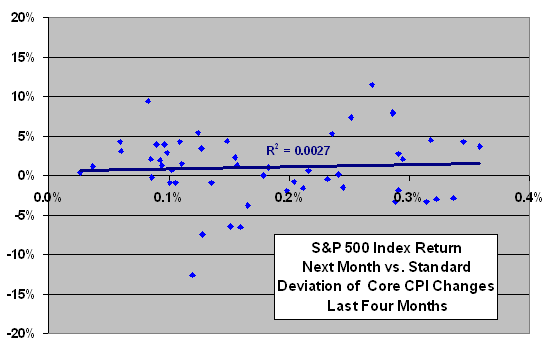A reader suggested that stocks may respond to two second order effects in the Consumer Price Index (CPI): (1)trend in monthly CPI changes (monthly inflation rate), as measured by the slope of changes over a few consecutive months; and, (2) volatility of monthly CPI changes, as measured by the standard deviation of changes over a few consecutive months. Testing these effects with CPI data and monthly S&P 500 index closing levels for estimated or actual CPI release dates during January 1990 through June 2007 (210 months), we find that:
The following scatter plot depicts the relationship between the change in the S&P 500 index over the next month and the slope of (trend in) core CPI changes over the previous four months. To avoid overlap of inflation rate trend inputs, we use every fourth month ( resulting in 52 consecutive four-month intervals). The Pearson correlation between these two series is 0.09, suggesting little or no relationship (especially not a negative relationship). The R-squared statistic for the distribution is just 0.0073, indicating that the inflation rate trend over the past four months explains less than 1% of stock returns the next month. Results do not support our first hypothesis.
Trend measurements over the last three, five and six months yield similar results. Analysis of the trend in total CPI changes rather than core CPI changes also produces similar results. Trends in simple and percentage monthly changes in 12-month trailing total and core inflation likewise show no noticeable correlation with next-month stock returns.
How about volatility of monthly CPI changes?

The next scatter plot depicts the relationship between the change in the S&P 500 index over the next month and the standard deviation (volatility) of core CPI changes over the previous four months. To avoid overlap of inflation rate volatility inputs, we again use every fourth month (resulting in 52 consecutive four-month intervals). The Pearson correlation between these two series is 0.05, suggesting little or no relationship (especially not a negative relationship). The R-squared statistic for the distribution is just 0.0027, indicating that inflation rate volatility over the past four months explains less than 0.5% of stock returns the next month. Results do not support our second hypothesis.
Volatility measurements over the last three, five and six months yield similar results. Analysis of the volatility of total CPI changes rather than core CPI changes also produces similar results. Volatility of simple and percentage monthly changes in 12-month trailing total and core inflation likewise show no noticeable correlation with next-month stock returns.

In summary, investors/traders appear not to consider recent inflation rate trend or volatility in deciding whether to buy or sell stocks.